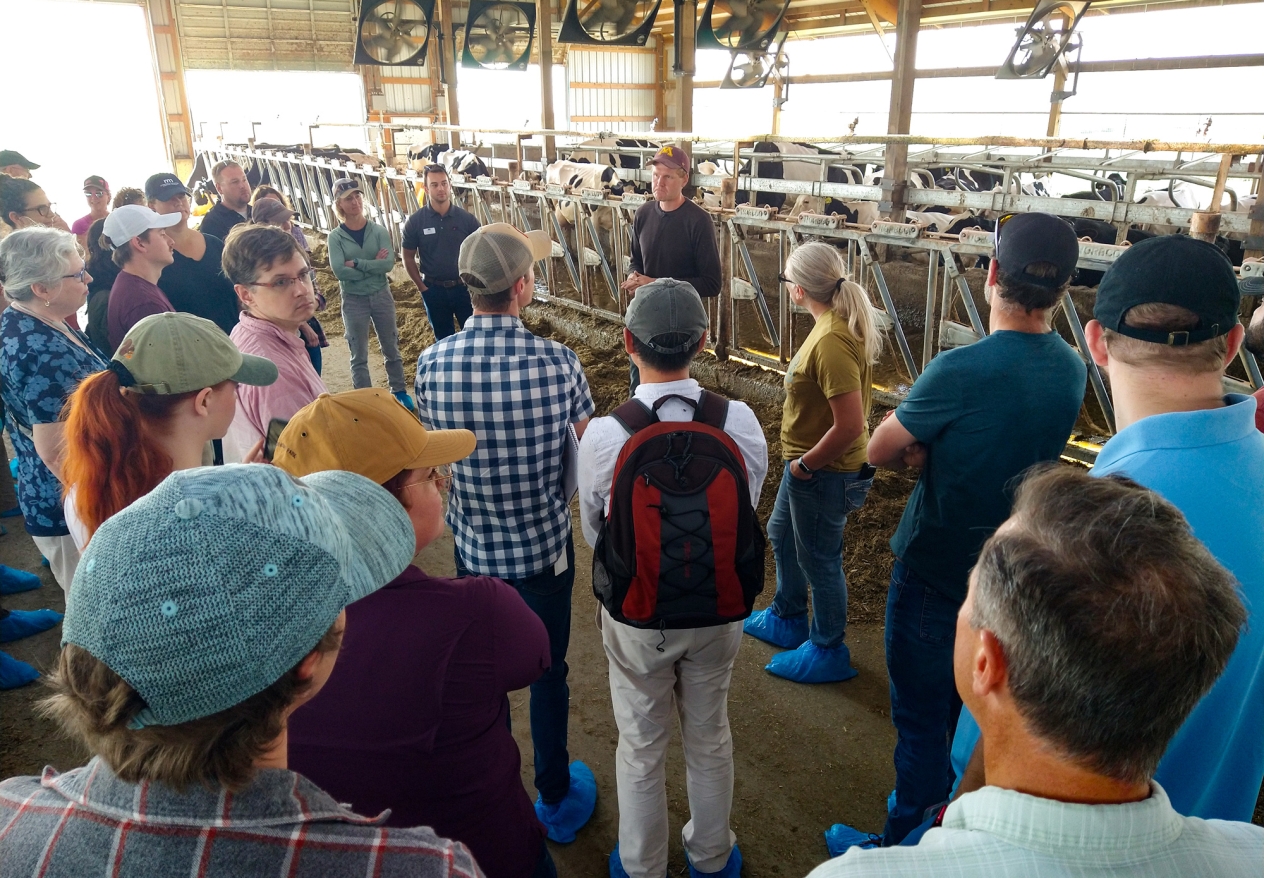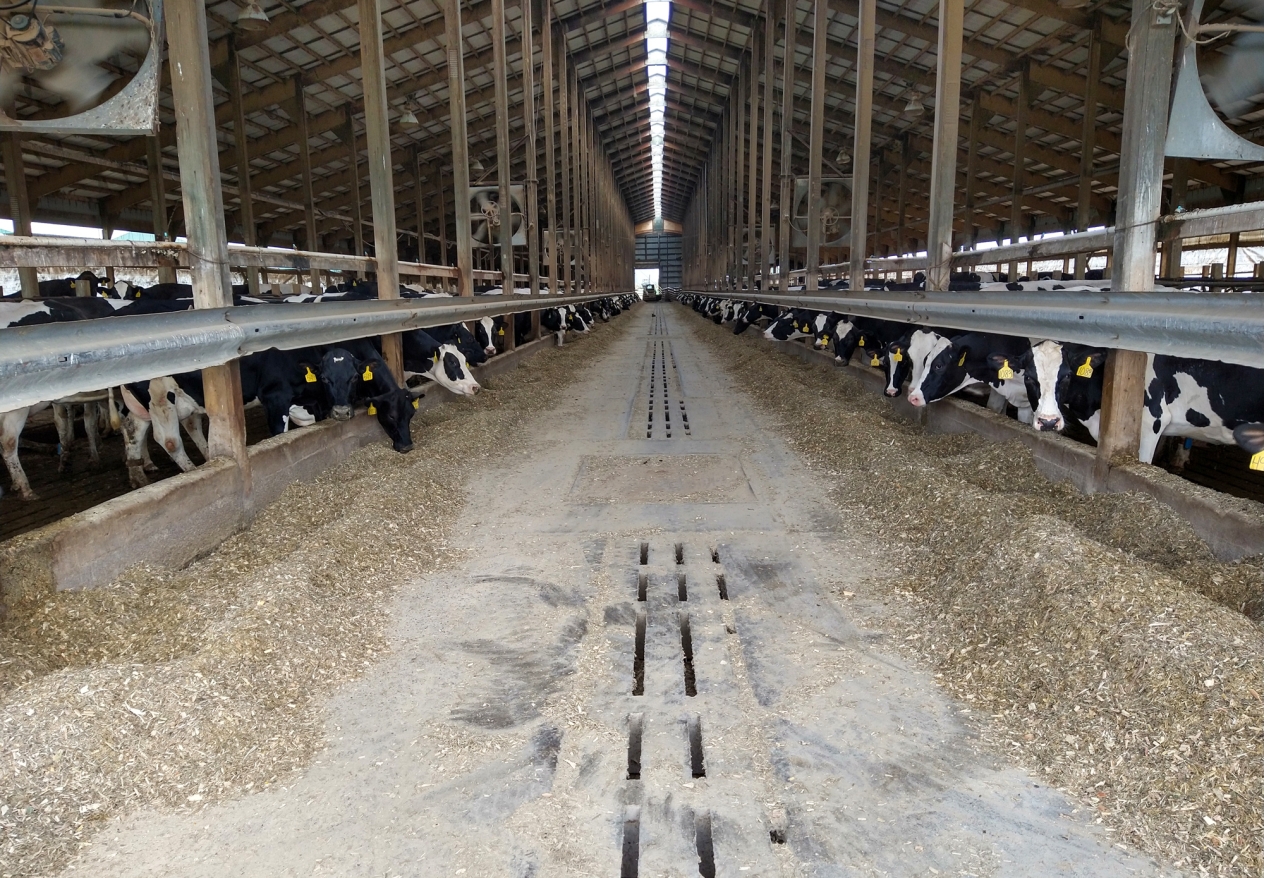From one end to the other, the barns stretched 500 feet, an open expanse without stalls where lowing cattle or gobbling turkeys could roam the full length and choose where to eat. Large fans spread cooling mists to push back the late-summer heat while open fields lay just outside.
In the middle of the barns, a couple dozen MPCA employees touring the farms gathered to listen to the farmers who run them. Each farmer told a different story, but common themes arose on every visit: innovation, technology, animal health, caring for neighbors and the environment.
“This is a great learning opportunity for our staff,” said feedlot environmental specialist Jason Kaare. “But it is also a great opportunity to strengthen relationships with our farmers in greater Minnesota.”
Kaare, who is based in the Marshall regional office, organized the daylong tour. Before joining the MPCA, he worked almost a decade as an agriculture science teacher.
“Educating people about farming has always been a passion of mine,” he said. “I know there’s always value in educating people about what happens on farms and where their food is coming from.”
The MPCA employees who took part in the tour ranged from hydrologists to engineers to writers. It was a diverse group brought together by a desire to learn more about farming. For their part, the farmers were hoping to educate agency workers and promote relationships. Kaare said it’s important for people working within a regulatory agency to understand what happens on a day-to-day basis on a farm, and how regulations can impact them.
“We need to work together on things,” he said.

Hyde Park Holsteins
The tour began at Hyde Park Holsteins in Zumbro Falls, where Justin Siewert greeted MPCA staff as they got off a bus. Siewert is the fourth generation of his family to work the farm, which his great-grandfather purchased in 1940.
The tour got up close and personal quickly as the group entered a milking parlor, where udders hung at eye level, and workers cleaned teats with iodine, a precaution that helps prevent disease. The cows walked in, took their spots, and then turned around to leave when their turn was over.
“They pretty much have it figured out,” said herdsman Eric Hanson.
Hanson said the farm pairs new cows with experienced ones from a herd of 680. The cows are milked three times a day, and after about two days, the cows learn what to do. The milk is made into cheese in Blair, Wisconsin, and is then distributed throughout the region.
“Things don’t always go perfectly, but most farms are trying to work within the framework that we have to work with and do the best that we can on the environmental regulatory side as well as the animal welfare,” Siewert said.
Siewert described how the farm uses sand as bedding, which gives the cows a comfortable place to rest, which ultimately improves milk production. The farm washes and recycles the sand on site, a process that improves hygiene and efficiency. It’s just one improvement the farm has seen in recent decades.
“It’s a continual process of continuous improvement,” Siewert said.

Perkins Family Farm
Fifth-generation farmer Tom Perkins greeted the staff at Perkins Family Farm in Red Wing, which has been in operation for 157 years, almost as long as Minnesota has been a state.
Perkins operates his farm’s barns, bedding, ventilation, and manure storage a bit differently, but everything Perkins said demonstrated the constant calculations he makes to ensure the health and safety of his 1,300 cows. His milk goes to Farmington to make yogurt and cottage cheese.
Perkins said he stores manure in multiple places around the farm so that during big rain events, he can move it around if needed. He also spreads some manure on his fields and sells some to neighbors.
“It’s good for people to see what’s good, to present a positive thing,” he said.
The cows at both locations were fed corn silage, hay, soybean byproducts, and supplements of fruits and vegetables. Improved nutrition means higher milk production, the range between the farms being 10-13 gallons per day from each cow. Ankle monitors and computer algorithms help determine nutrition and health needs.

Truthahn LLC
Biosecurity was the word of the day when the tour stopped by Truthahn in Kenyon, which operates three barns in which it raises turkeys for Jennie-O. Mark Comstock greeted the group with gratitude that everyone was already wearing fresh disposable covers over their shoes to prevent the transmission of bird flu.
MPCA staff did not go inside the barns, which requires multiple steps for farm workers. First, they put on clean coveralls. They then don face masks, head gear and gloves, and step into decontaminating dipping pans. When they leave the barn, their tools are sprayed with disinfectant.

From a viewing area, Comstock explained that the group wasn’t looking at Thanksgiving birds, which would be female and grow to 30 pounds. Instead, they were looking at male turkeys, which arrive weighing one pound and grow to 48 pounds in 140 days.
Careful procedures help keep the birds calm, safe and secure. Each new flock gets new bedding of wood shavings, which is tilled twice a week to dry it out. This also keeps ammonia from building up and starts the compost process. Their manure is used as fertilizer on crop fields, which are tested to prevent pollution from runoff.
“We’re always testing for phosphorous,” Comstock said.
Jennie-O takes the grown birds for processing using a conveyor system monitored via cameras to ensure workers treat the birds gently. They load at night to keep the birds calmer. After each flock leaves, workers clean the barns, top to bottom, before bringing in the next batch. The facility is licensed for 17,500 birds per barn, but they’ve been putting in 13,300, which has helped the birds’ weight increase.
“We’ve been here for a long time,” said Comstock, a sixth-generation farmer. “We take a lot of pride in what we do. We take a lot of pride in our neighbors. If we can make rules we can all live by, I’m very happy with it. I think 99% of the farmers would be happy with it. We’re not out here to make enemies.”
The takeaway
Kaare’s interactions with farmers are often procedural, walking around manure pits, looking for damage to walls, checking records and discussing solutions to any issues. But he said the interactions are personal, too.
“We are going to their home; we are going to where they live,” Kaare said. “This is where they are raising their family, and this is their livelihood, and so as an inspector, you have to be mindful of that, and you have to try to build a relationship with them and have some level of trust.”
Amy Timm, an MPCA watershed environmental specialist, doesn’t interact with farmers in her job, but said it was good to take the tour to see what Kaare and other colleagues see when they visit farms.
“It’s good to have that awareness,” she said.
David Satzke, an MPCA community affairs specialist, said he appreciated seeing the different styles of farming on the tour.
“It makes clear how we have to pay attention to not lump all farms into one category and one way of doing things,” he said.
The day was also an opportunity to realize that, in one way or another, farming touches everything the MPCA does.
“Some people think we do not regulate farms and livestock enough, and some people think we do too much, and we are over-stepping,” Kaare said, “and so we have to find that line and that balance.”

